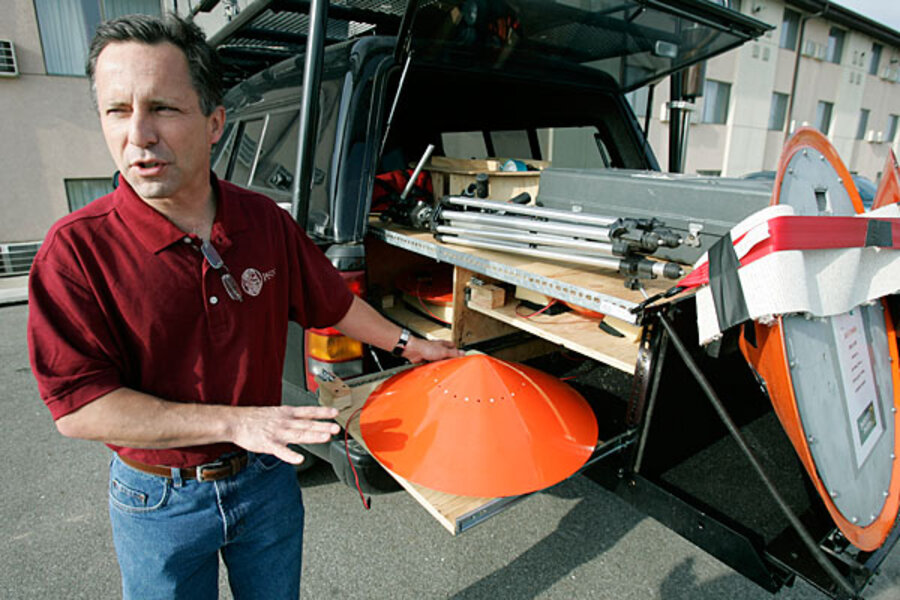Storm chasers killed by latest Oklahoma tornado
Loading...
On a day when many storm chasers acknowledged that they take too many risks in order to get the most sensational videos, one of the safest and most professional storm chasers of all died.
Even before the death of Tim Samaras became public Sunday, the El Reno tornado in Oklahoma Friday had spawned serious introspection among the storm-chasing community. The Weather Channel's Mike Bettes, who two years before had called out storm chasers as hypocrites for saying "safety is their No. 1 concern and warning the public is their number No. 1 priority," found himself flung 200 feet in his custom "Tornado Hunt 2013" SUV.
"I thought I was doing the right thing, but obviously I wasn’t," he wrote on his Facebook page.
He and his crew emerged with only minor injuries. But the deaths of Mr. Samaras and two other members of his team – son Paul and colleague Carl Young – are a bitter irony. Samaras took risks, to be sure. He said he knew the smell of a tornado – a scent of new-mown grass and broken gas lines – and once got so close that "debris was flying overhead, telephone poles were snapped and flung 300 yards through the air."
But among the extreme-weather community, Samaras was known as someone whose No. 1 concern was safety and whose No. 1 priority was warning the public. In a field where so many storm chasers have become little more than meteorological paparazzi, seeking a glory moment on social media or the 24-hour news channels, Samaras remained a scientist at heart, fascinated by the awesome power of nature's fury and determined to understand the many mysteries that still elude tornado researchers.
The details of Samaras's death have not yet been shared publicly, but the story of the Weather Channel storm chasers underscored one of the field's greatest risks: getting caught with nowhere to drive when a storm bears down on you.
Sometimes, "you don't have enough options, road-wise, to get out of there," said Greg Forbes, a severe-weather expert at the Weather Channel, in an interview on the channel's website. Sometimes, victims can get caught in traffic jams – indeed, several of the nine fatalities on Friday came when a tornado hit a packed section of Interstate 40.
In an interview with National Geographic earlier this year, Samaras noted that storm chasers can create their own traffic jams – particularly now during peak tornado season in Oklahoma.
"On a big tornado day in Oklahoma, you can have hundreds of storm chasers lined up down the road," he said. "Oklahoma is considered the mecca of storm chasing. We know ahead of time when we chase in Oklahoma, there's going to be a traffic jam."
In theory, the storm chasers are there as a public service. Tornado prediction remains challenging. Samaras noted that only 2 of every 10 storms he chased spawned a tornado, in a different National Geographic interview. That means having many spotters on the ground actually serves a valuable purpose in telling meteorologists where twisters are and where they're headed.
"There's tremendous amount of value from spotters and storm chasers," Dr. Forbes told USA Today in a second interview.
But Samaras's interest went beyond tornado-spotting. To help scientists better understand what happens inside a tornado, he invented various instruments, most notably "the turtle" – a low, cone-shaped probe that can hug the ground as a tornado passes overhead.
"We still don't know why some thunderstorms create tornadoes while others don't. We're trying to collect as many observations as possible, both from outside and from the inside," he told National Geographic. "If we understand the [storm's] thermodynamic profile – what's the temperature, what's the humidity like, how cool is the air outside of the tornado – these are clues that help us to measure a thunderstorm that may produce a tornado."
In addition, "we're also trying to address tornado dynamics – how powerful the winds are near the surface – which will help us address some of the engineering issues with home building," he added.
One of Samaras's turtles recorded the biggest drop in atmospheric pressure ever recorded – a drop of 100 millibars in 10 seconds – when a South Dakota tornado passed directly above it in 2003.
"That's the closest I've been to a violent tornado, and I have no desire to ever be that close again," he told National Geographic.
He sprang from his car when the tornado was only 100 yards away to plant the device. Sixty seconds later, the tornado had arrived.
"The rumble rattled the whole countryside, like a waterfall powered by a jet engine," he added.
His commitment to the scientific aspects of storm chasing made him invaluable within the extreme-weather community.
"He was a pioneer in terms of taking scientific measurements," Forbes said on the Weather Channel. "We can do things with Doppler radar, but you're getting measurements there 10s to 100s of feet above the ground. We need to know what's happens right down at ground level."
What's more, Samaras was a leader in promoting safety among storm chasers. He and colleague Roger Hill have been holding an annual chaser convention, ChaserCon, in Colorado for the past 15 years. In recent years, more than 300 people have attended, Forbes said.
"He was involved in trying to make people better chasers – educating and research, that was his life," he added.








